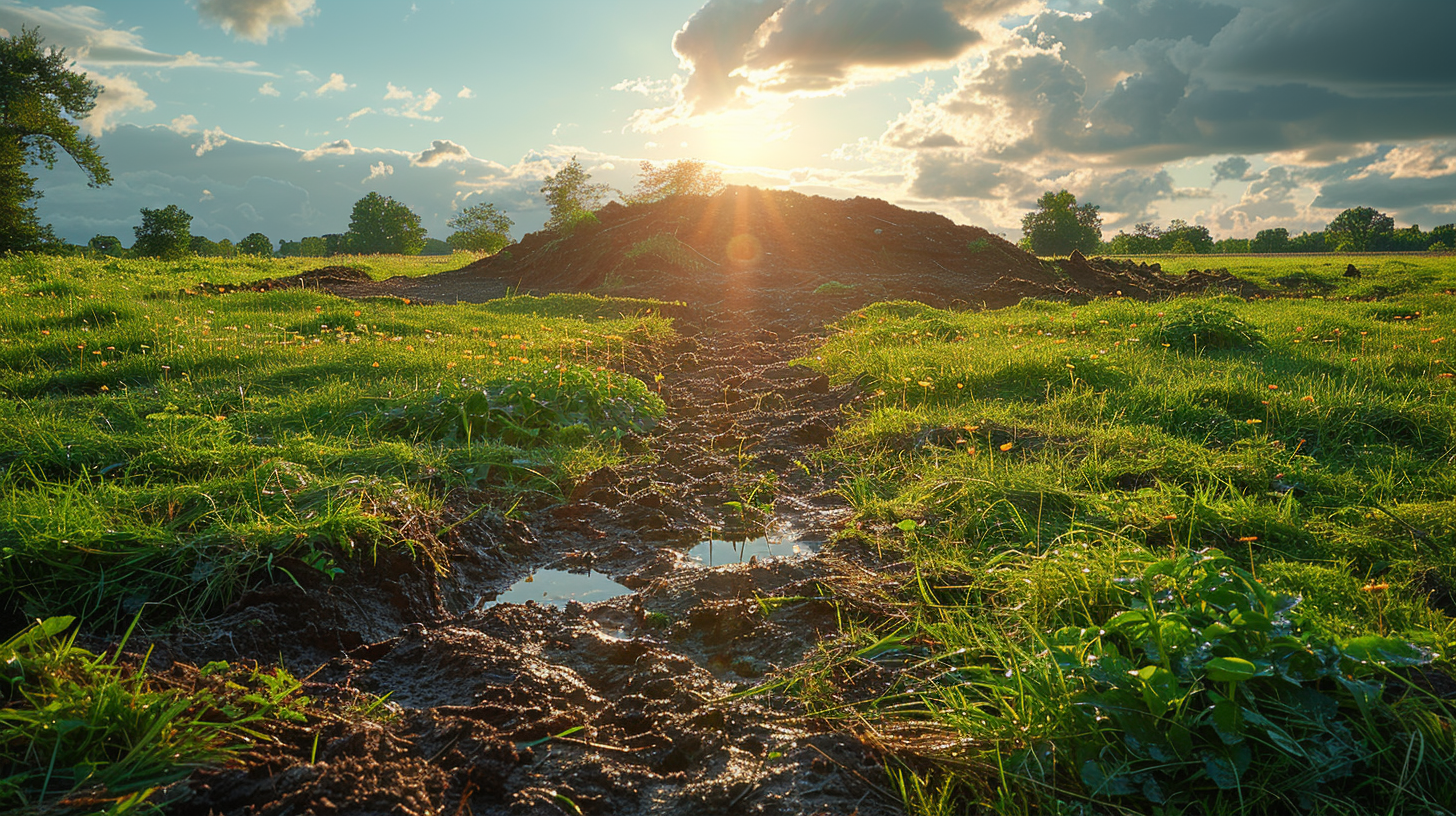Key points
• Sand Filter Treatment: In a sand mound septic setup, effluent gets pushed from the tank into a pile of sand for extra cleaning. The sand is like a natural screen that catches dirt and germs as the water drips through it.
• Effluent Distribution: There’s also a bunch of holes in pipes spread out inside the sand pile. They make sure the effluent goes everywhere evenly, so every part of it gets cleaned the same. This stops any single spot from getting too much liquid and messing up the process.
• Soil Absorption: Once the effluent passes through the sand. It seeps into the dirt beneath. Here, tiny organisms in the soil finish cleaning the water. They eat up what’s left of the bad stuff, and then, cleaner than before, the water goes back into the ground.
Contents
- 1 Key points
- 2 Getting to Know Sand Mound Septic Systems
- 3 Understanding How Sand Mound Systems Work
- 4 Septic Tank
- 5 Dosing or Pump Chamber
- 6 Sand Mound Structure
- 7 Understanding Wastewater’s Path
- 8 Treatment and Filtration Mechanism
- 9 Wastewater Treatment and Disposal
- 9.1 Soaking into the Surrounding Dirt
- 9.2 Cleaning Further Before Hitting Groundwater
- 9.3 Testing Soil Soak-up Skills
- 9.4 Keeping Away from Water Tables
- 9.5 Picking the Right Size
- 9.6 Laying Out the Mound
- 9.7 Keeping Things Running Smoothly
- 9.8 Spotting Issues Early
- 9.9 Effects on Local Nature Spots
- 9.10 Stopping Pollution
- 9.11 Fitting In with Natural Water
- 9.12 Staying in Line with Laws
- 10 Getting Permissions and Design Rules
- 11 Frequently Asked Questions (FAQ)
Getting to Know Sand Mound Septic Systems
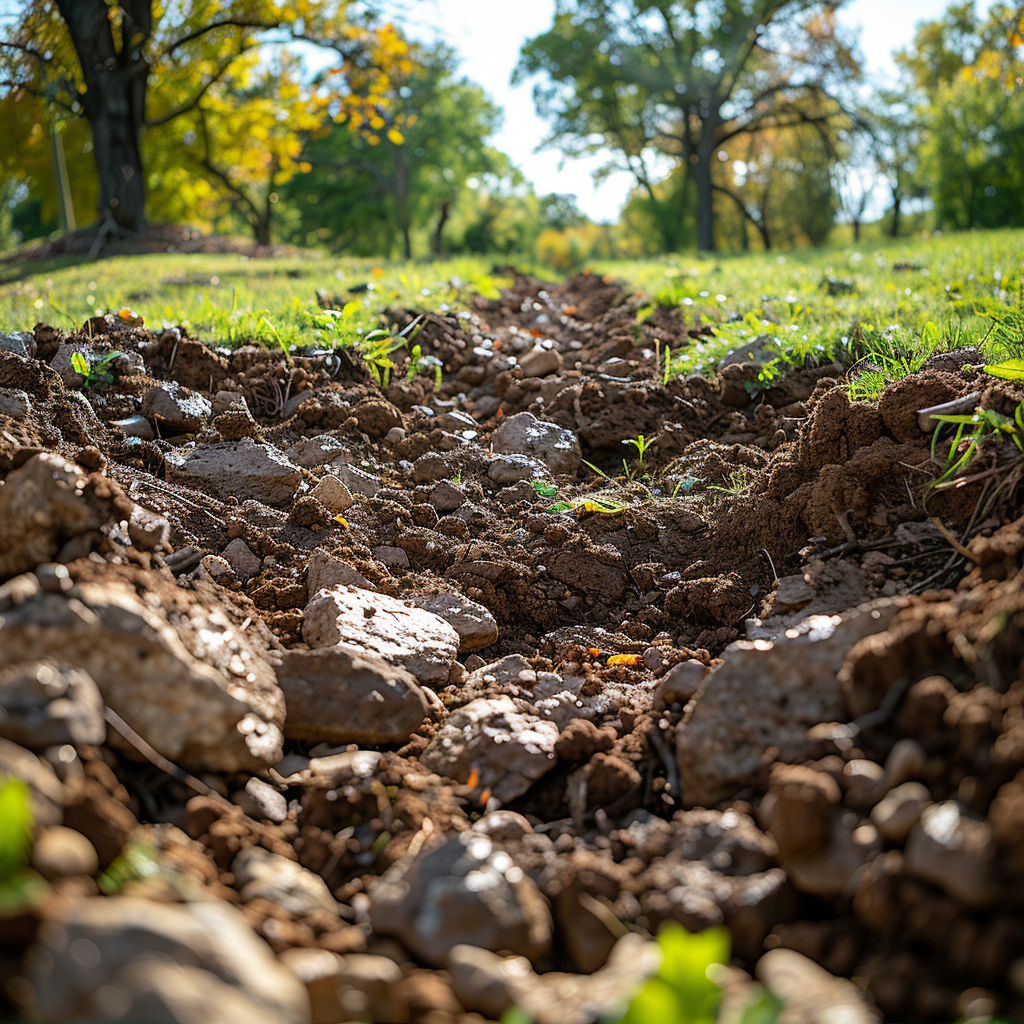
A sand mound septic system is another way to deal with waste, different from the usual septic systems. It’s mostly used where there’s a high water table or the soil’s not good enough, and it’s crucial for getting rid of waste where normal methods won’t work.
What is a Sand Mound Septic System?
This system has a leach field that sits above the ground. It’s made for places where typical systems can’t do their job, by using a pile of sand and gravel to clean and treat the dirty water from the septic tank. If the soil in an area isn’t right for the standard septic setup, this is a good plan B.
How Sand Mound Systems Differ from Regular Septic Systems
Unlike usual septic systems, a sand mound system needs a pump that sends the dirty water to a specially made mound filled with layers of sand and gravel. This acts as a filter when the right kind of soil isn’t there.
When to Use Sand Mound Systems
If you have a place with a high water table or soil that’s either too leaky or too tight, regular septic systems might not work well. That’s when you might go for a sand mound septic system because it can handle sewage treatment and disposal in these tough situations.
Understanding How Sand Mound Systems Work
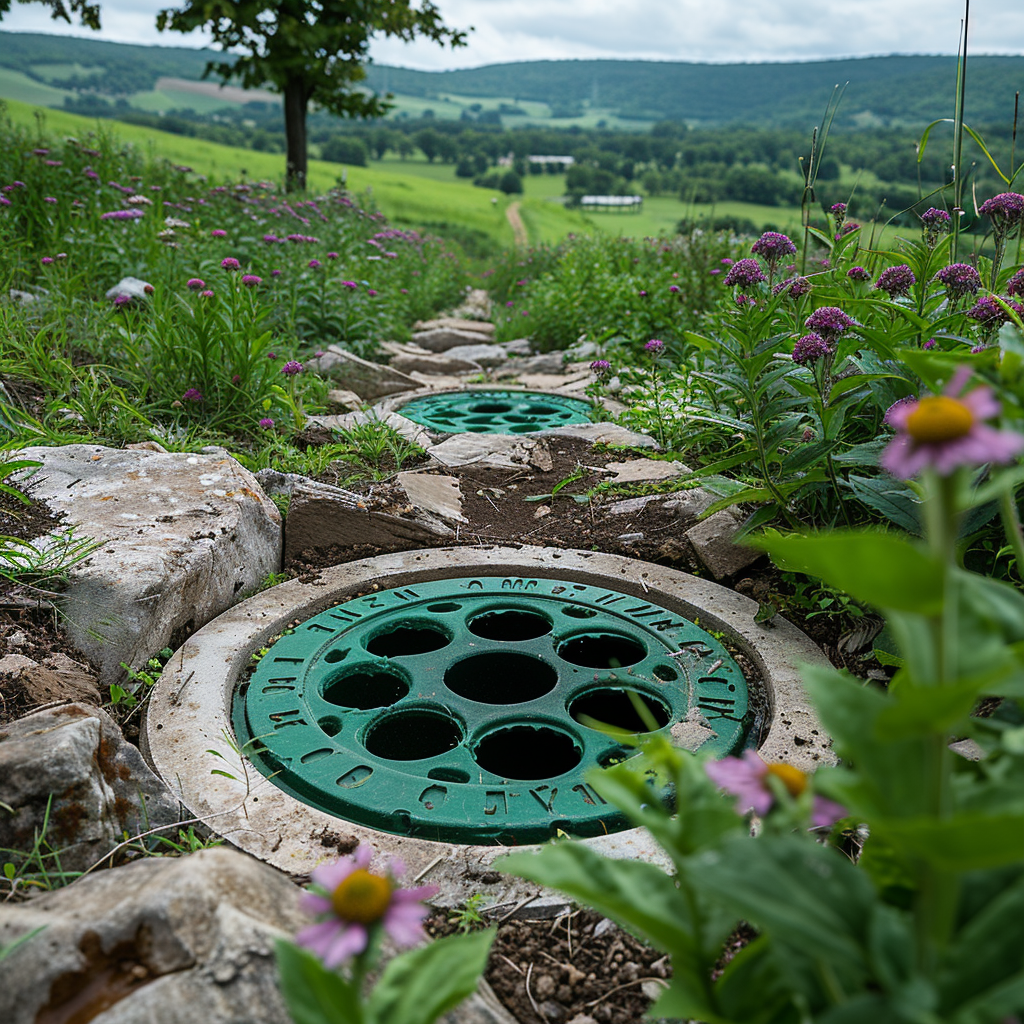
Knowing how a sand mound septic system operates is crucial. If it works right, it deals with waste well and keeps our environment safe from harm. This system is key when health rules need special waste treatment methods for difficult locations.
Waste Treatment and Saving the Environment
A sand mound’s main job is to clean the wastewater before it goes back into the earth. It’s made of layers that act like a filter, taking out the bad stuff from the water. This is super important for keeping people healthy and looking after nature.
Following the Rules
When you put in a sand mound septic system, you’ve got to stick to the tough health and building laws. They’re there to protect everyone and everything around. Getting this type of septic system right means you’re following the law and your property’s wastewater is handled the way it should be, especially if normal septic options won’t work there.
Septic Tank
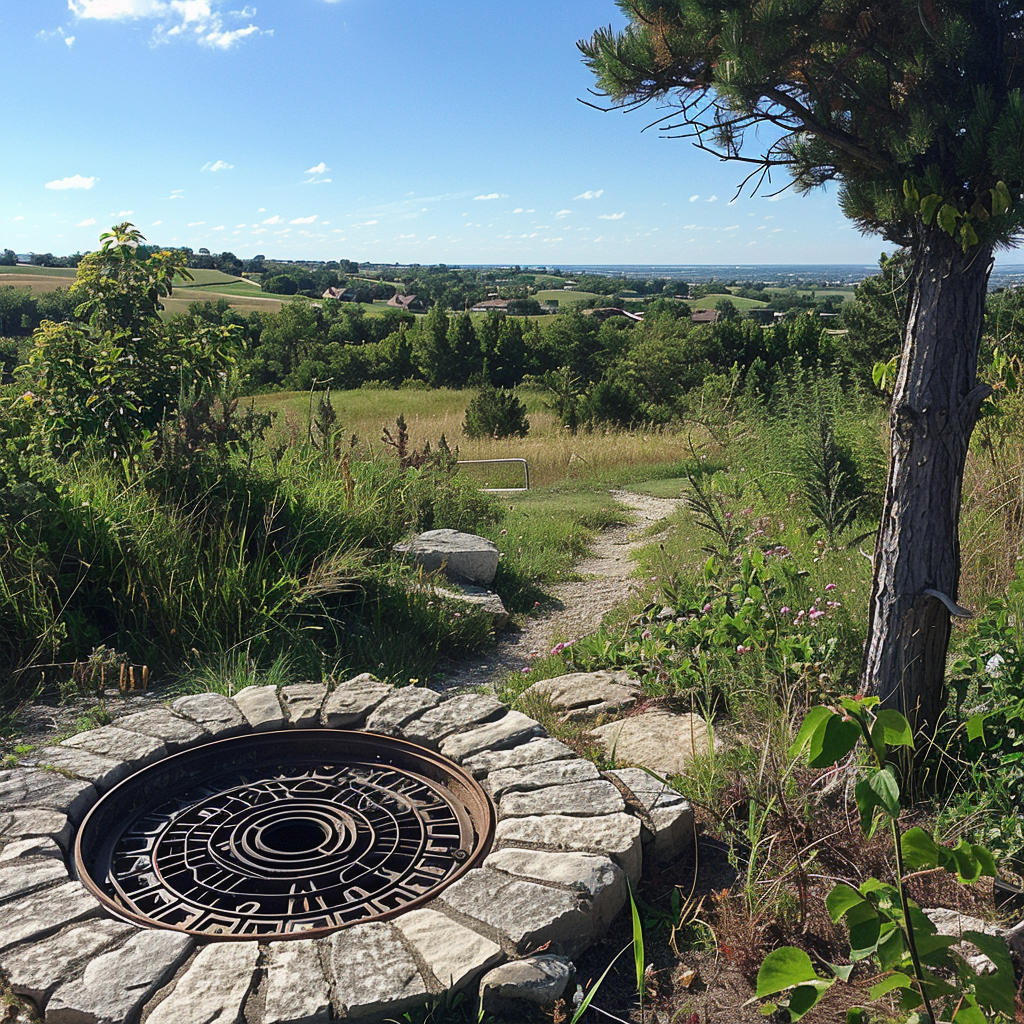
A septic tank is the first step in cleaning up the water waste from homes. Its main job is to split the solid stuff from the liquid waste, which makes the following cleaning steps easier. In this tank, the heavy bits fall to the bottom and make a sludge layer, while fats and oils float to the top and form a scum layer. The water between these two layers is pretty clear, and it moves on to the next step to get treated.
Dosing or Pump Chamber
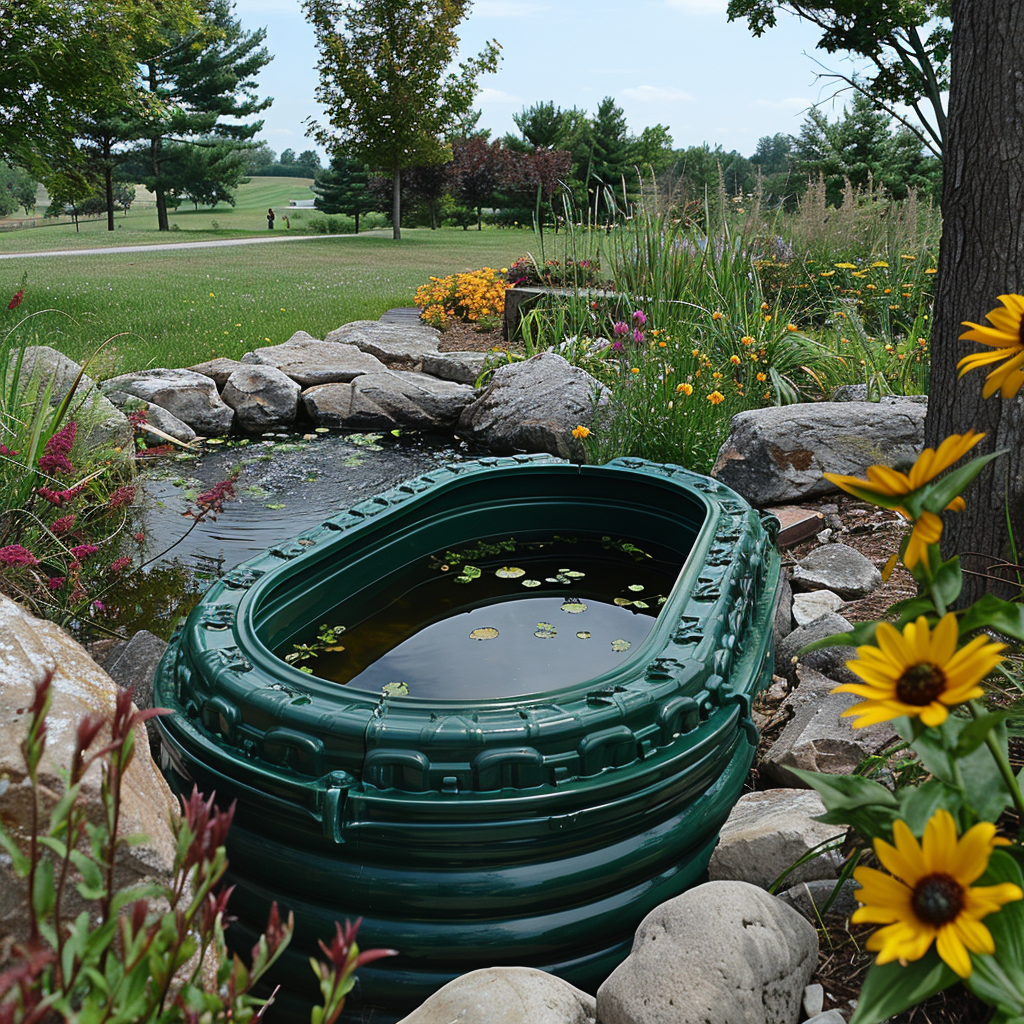
A dosing or pump chamber is a key part of a sand mound septic system. It helps control how the wastewater goes to the sand mound. The chamber works on a schedule, sending out set amounts of effluent at specific times. This stops too much waste from hitting the mound all at once, which means the system can clean the water better before it trickles through the ground.
Sand Mound Structure
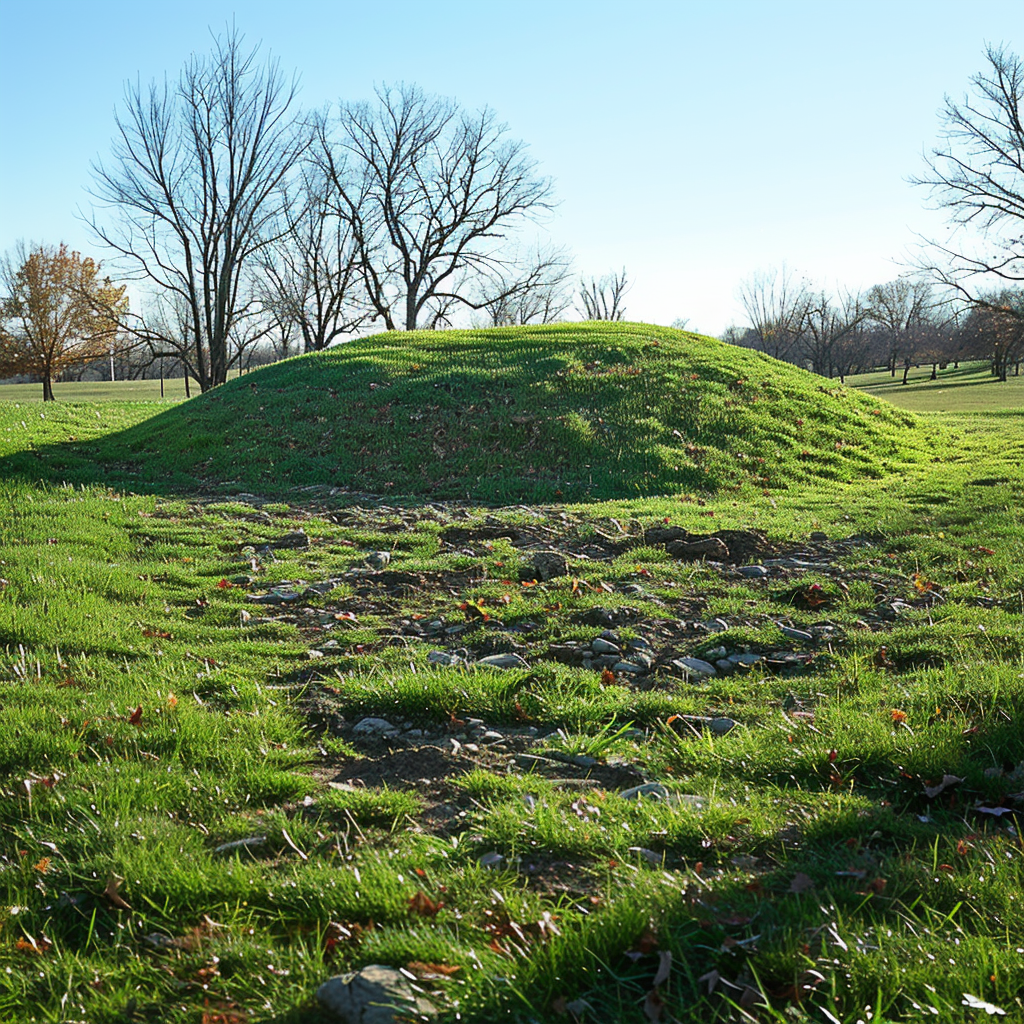
A sand mound is made of several layers: sand, gravel, and rich soil at the top. This setup helps clean wastewater before it goes back into the ground. Here’s the structure in detail: The bottom layer has gravel, which spreads out the liquid waste. On top of that, there’s a thick sand layer that filters out more dirt. Then, you’ve got good topsoil on the surface where plants can grow; these plants take in nutrients from the waste. Together, these parts work to remove harmful substances as the water drips through and eventually ends up in the underground water sources.
Understanding Wastewater’s Path
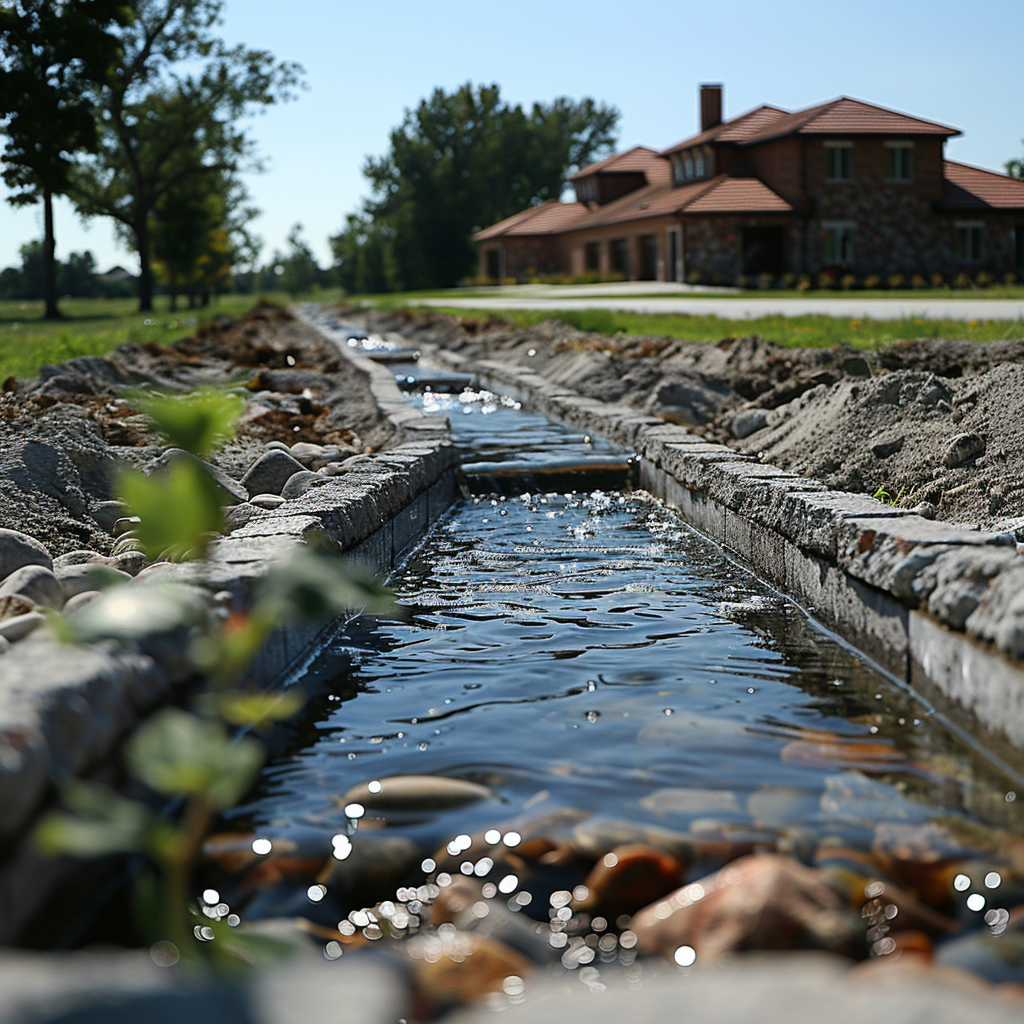
The path of wastewater from a home starts with its trip to the septic tank. Here, all the dirty water from the house pours into the septic system, mostly using gravity. Next, it moves to an important part: the dosing chamber. This place is key because it gets the wastewater ready for a measured release into the sand mound.
From Home to Septic Tank
Anything that goes down your sinks or toilets ends up in the septic tank. It’s a big container where heavy stuff sinks and lighter stuff floats. This first step makes sure only the watery part, called effluent, goes forward in the process.
Moving to the Dosing Chamber
After things have been split up in the septic tank, the liquid flows to the dosing chamber. The job here is all about accuracy. This chamber sends out the water at set times and amounts, making sure it reaches the sand mound evenly spread out.
Onward to the Sand Mound
The final part of the process before cleaning the water is when it’s spread across the sand mound. Pipes lay out the effluent evenly so it covers all of the specially made sand area properly.
Treatment and Filtration Mechanism
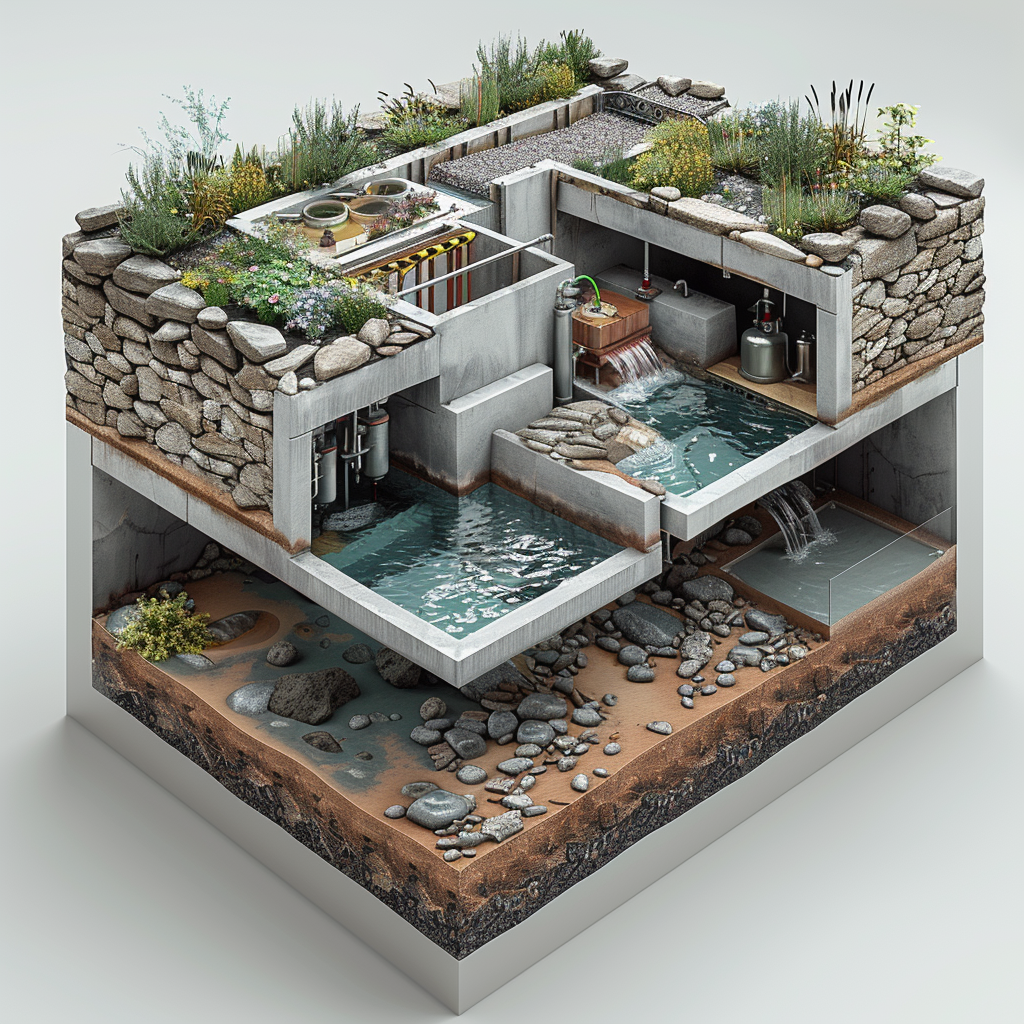
The design of the sand mound is pretty smart – it cleans wastewater in two main ways: through physical and biological methods. The wastewater seeps through the sand and gravel, leaving behind solids, and starts to get cleaner.
Physical filtration through sand and gravel
The layers of carefully chosen sand and gravel work as a filter. They catch the dirt and spread the water out evenly because they have lots of tiny holes.
Biological treatment by microorganisms in the soil
The biological side is just as critical. Imagine a busy city underground; tiny organisms that live in the soil eat up the pollutants in the wastewater. As they munch away, they transform these bad substances into stuff that isn’t so harmful.
Wastewater Treatment and Disposal

At the end of the process in a sand mound system, wastewater is absorbed into the nearby soil. This is where extra filtering occurs as a final touch by nature.
Soaking into the Surrounding Dirt
After passing through the sand and gravel layers, the now clean water seeps into the soil. Here, the ground acts like a sponge, taking in the treated wastewater and adding it to its moisture levels.
Cleaning Further Before Hitting Groundwater
The water’s journey isn’t over. It gets even cleaner as it moves down towards groundwater supplies. The soil and tiny organisms act as additional cleaners, making sure our crucial underwater sources stay safe.
To put in a sand mound septic setup, you must check out the land first. You need to look at the soil to see how well it soaks up and filters water, because this is key to the system working right.
Testing Soil Soak-up Skills
Before building a sand mound, you do tests to see how fast water gets sucked up by the soil. Experts perform these tests to make sure the chosen spot can handle and clean the water properly. If the soil soaks it up too fast or too slow, there could be problems like not cleaning the water enough or causing blockages.
So, you might have to tweak the design of your sand mound based on these test outcomes. Changes in size or layout are made to fit how the soil behaves, ensuring your wastewater is treated well.
Keeping Away from Water Tables
When planning a sand mound for septic needs, it’s important to keep enough space between the drainage area and the water table to avoid polluting it.
If the water table is close to the surface, you may need to build a taller mound. That could also mean a bigger overall system. These are things you’ve got to think about for both environmental protection and making your septic system last.
To make a septic system that can handle your wastewater, pay close attention to size and design. The sand mound should be right for your specific situation so it works well and lasts long.
Picking the Right Size
You have to think about how many people are in your home and how much wastewater they make when sizing your system. It’s got to deal with daily use and unexpected heavy days without struggling. Plan for extra just in case, so your system can handle busy times with no problem.
Laying Out the Mound
The shape and setup of sand mound systems have to be spot on – there’s no guessing allowed. The terrain affects how big and wide you can make your system. These details need careful measuring to get rid of waste effectively without messing up the soil. Each bit forms part of a complex approach that balances treating waste against being kind to nature.
Beyond just numbers, features like slope, length, and width make sure that everything works without harming the planet. This careful planning shows engineering that thinks about its impact and aims to be as green as possible.
Getting sand mound systems right involves detailed science and forward-thinking. Deciding on size and planning physical dimensions set up a strong and eco-friendly septic setup.
Keeping Things Running Smoothly
You’ve got to watch a sand mound system closely and give it check-ups to keep it going. Inspections help catch problems before they get big. It’s key to check that things like tank levels are normal, suggesting no leaks or issues, and that pumps are working fine moving water to the mound. Another important part of caring for your system is keeping pipes clear so effluent spreads out evenly over the field.
Spotting Issues Early
If you pick up signs like bad smells, damp patches by the mound or really green plants, there could be trouble. You need to fix problems quick to keep your system working right.
This might mean unblocking pipes or fixing parts that aren’t doing their job. Getting onto issues fast helps your septic system last longer and protects health and nature.
When making septic systems on your own turf, you’ve got to factor in environmental effects and follow the rules. A good design needs to cut down on possible damage while ticking all regulatory boxes.
Effects on Local Nature Spots
Septic systems can change nearby wildlife areas a lot. But with careful planning, we can avoid hurting plants and animals by changing land use or water quality. Designers aim to keep ecosystems as they are by using methods that don’t throw off nature’s balance.
Stopping Pollution
One of the biggest goals with septic systems is to not let nasty stuff leak into our waters. By using modern cleaning techniques, we can protect our health and local environments from pollution risks.
Fitting In with Natural Water
It’s essential for septic systems to mesh well with how water naturally flows and fills back up in an area. This helps ensure that both the septic installation itself and nearby waters stay healthy in the long run.
Staying in Line with Laws
Finally, you can’t ignore state and local regulations when installing septic systems. Strict rules tell you how big, where, and how you can maintain systems in ways that keep them environmentally safe.
Getting Permissions and Design Rules
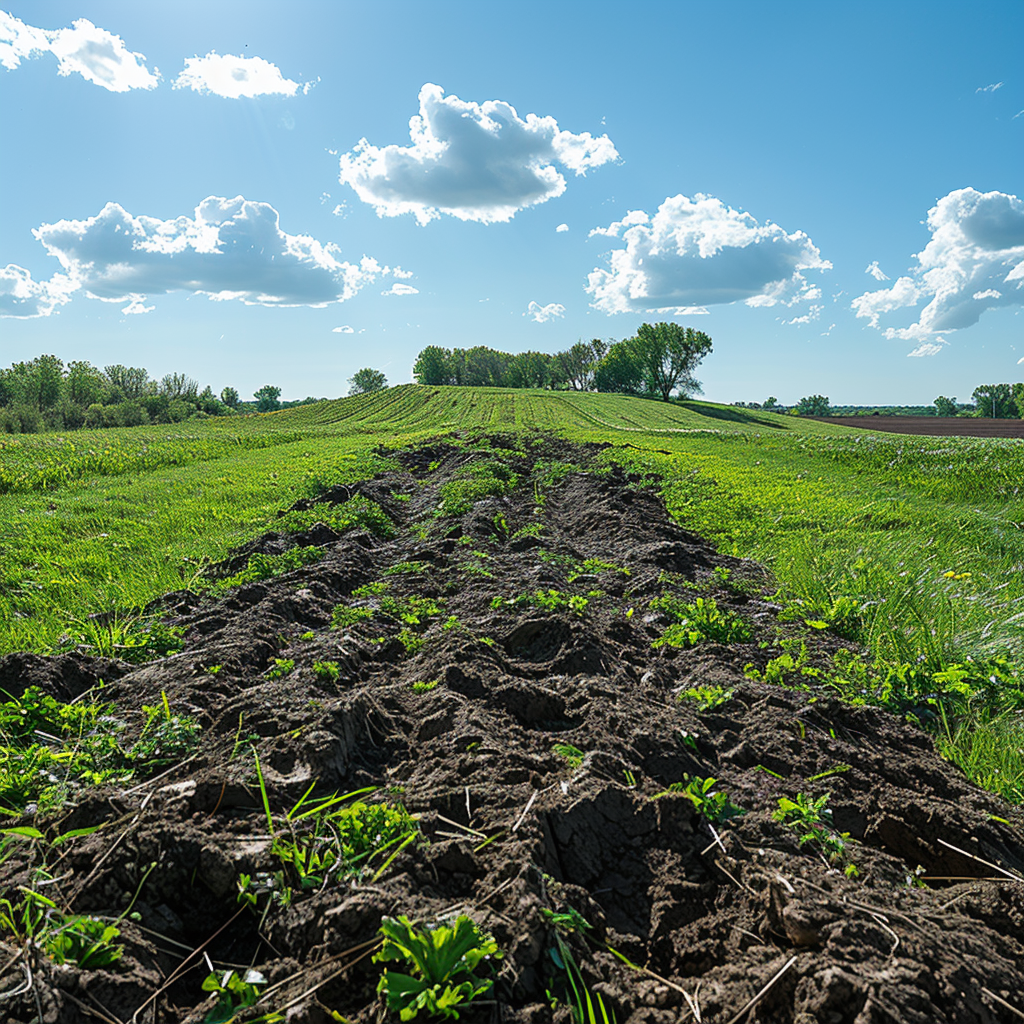
Getting a permit is crucial and shows why we must have detailed design rules for creating septic systems. These permits are important papers that prove the planned systems are built to protect the environment fully.
Ongoing Reports and Approvals for Septic Systems
You have to make reports and get approvals as part of keeping a septic system working right on your property. By keeping track of how the system’s doing, people can spot and solve problems fast. This helps keep the local environment healthy.
Frequently Asked Questions (FAQ)
What role does effluent play in a sand mound system?
In a mound system, effluent represents the treated wastewater that emerges from the septic tank; it’s spread evenly across the drainfield via pipes within the mound, facilitating further treatment by the soil before re-entering the water cycle.
Can you explain how a pump enhances a sand mound system's efficacy?
The pump is crucial in a sand mound septic system, pushing the effluent from the septic tank to the mound. It ensures even distribution for consistent treatment across the entire system.
How do drip distribution systems integrate with mound systems?
Drip distribution systems in mound setups delicately disperse effluent over expansive areas, capitalizing on slow-release methods which helps with more efficient wastewater absorption and treatment in differing soil conditions.
Why might a sanitary sewer system not be suitable compared to a mound system in certain locations?
In areas where standard sanitary sewer systems aren’t feasible – due to high groundwater tables or code restrictions – mound systems serve as a viable alternative, designed to fit specific lot conditions and soil types.
How do gravity flow drainfields contrast with mound systems?
Unlike gravity flow drainfields that rely on natural slope for effluent movement, mound systems use a pump to transport the effluent up to the raised bed, accommodating flat terrain or shallow soil over bedrock or high water levels.
Why is the design and size of a mound system critical for its operation?
Design and size of a mound septic system must be tailored based on lot size, household size, soil type, and other local conditions to assure it effectively manages wastewater without endangering health or water quality.
How does weather affect the operation of mound septic systems?
Extreme weather conditions can impact mound systems; excessive rain may lead to saturation, while freezing temperatures could hinder the biological treatment process within the mound structure.
What is POWTS and its relation to mound septic systems?
POWTS, an acronym often encountered in Wisconsin regulations, stands for Private Onsite Wastewater Treatment System, under which category mound systems are regulated, ensuring they meet health and environmental protection standards.
In what way do soil tests influence the design of a sand mound system?
Soil tests determine the percolation rate and absorption capabilities, essential factors in designing a sand mound septic system that will adequately treat and dispose of wastewater without causing contamination.
What does a polyethylene container represent in a mound system?
In some designs, the polyethylene container can be part of the pump chamber or even replace the traditional concrete or fiberglass tanks due to its durability and resistance to corrosion.

I’m Tim Robberts, a seasoned wastewater treatment & septic system expert with over 40 years of experience in the field. My career began as a septic tank installer, and I quickly gained a reputation for my attention to detail and commitment to excellence. Over the years, I’ve honed my skills in designing, installing, and maintaining septic systems for residential and commercial properties.
